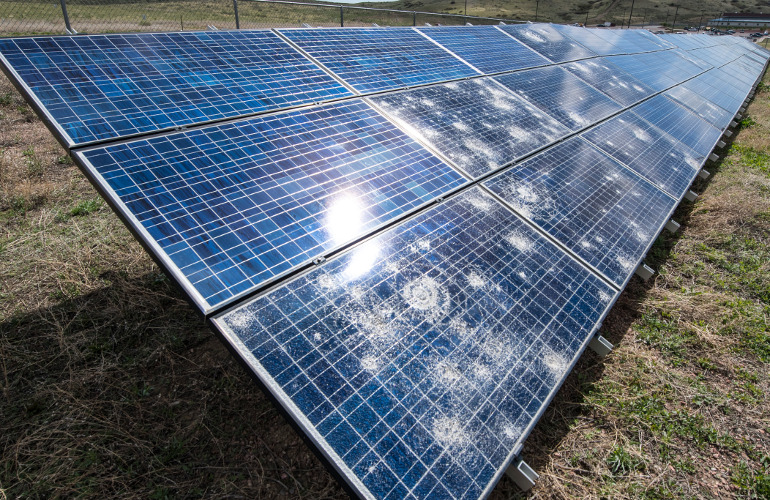
NREL -researcher Kate Anderson assesses a PV -Array that will be damaged in Fort Carson in 2019 in Fort Carson. Photo by Dennis Schroeder / NREL
VDE Americas and KWH Analytics have released a new form that assesses the hail risk and defense opportunities of a solar site for the coming hail season. Multiple controversial hail losses have caused insurance challenges for solar activa, so that the industry is fueled to take resilience measures, such as the use of thicker glasses of solar panels that are less susceptible to cracking. But for insurance companies to correctly evaluate the risk reduction, they need data.
To provide meaningful hail risk -evaluation data, VDE Americas and KWH Analytics have jointly the Greetings Storage and Risk -ValuatiToolAn easy -to -use assessment for insurers and financiers to confirm and monitor the functionality of the hail protection. Ultimately, projects that use this form and prove the effectiveness of their resilience efforts, get insurance credit. The form and recommendations are based on the extensive best practices of VDE for hail defense, which, among other things, store a proactive solar panel, use sector -specific hail prediction and on reports -based hail message.
Greetings STOW refers to the positioning of solar trackers on steep corners during hail showers to minimize the impact and protect solar panels against damage. VDE Americas advises solar projects under construction to set up solar trackers, the devices that adjust the tilt of solar panels, in Hagel immediately after installing the panel. For projects that are in operation, the company recommends implementing hailmonitoring with surplus regional and site-specific reports that are confirmed automated or manual hail storage, confirmed by staff after triggering, the testing of hail reinforcement capacities prior to the needs and placing trackers and placing the posting of the needs and placing the posting of the needs and placing the posting of the needs and placing the place of the needs of the needs and placing the posting of the needs and placing the place in the needs and placing in halpers.
KWH Analytics’ and VDE America’s approach to risk modeling uses radar-based weather data and equipment-specific hail reputation characteristics to create a data-driven model that rewards resilient design and operational excellence. By including reliable, location -specific hail risk data and performance statistics of equipment, this approach creates a more accurate framework for risk assessment that proactive solar owners and operators benefit.
“While we navigate with a serious hail risk through a La Niña year, the threat of damage to solar projects is extraordinary,” says Nicole Thompson, Senior Manager, Data Science at KWH Analytics. “Our evidence-based premium differentiation rewards projects with proven defense strategies, which send an insurance price signal to the industry and stimulate the design, construction and operation of more resilient solar activa.”
KWH Analytics made the Hail Stow and Risk Evaluation form for easy to use. There is an option to enable insurers to connect to Tracker manufacturers and independent engineers directly for project specifications. The hail message and risk evaluation framework works together with VDE Americas’ Hail Risk Intelligence Suite to tackle the vulnerabilities of solar projects for hail. The evaluation offers insurers standardized criteria for assessing the willingness to the hail, while the Intelligence Suite operators rests with practical instruments -including hail risk -engineering reports, a hail risk -atlas with ArcGis analysms, technical guidance for storage procedures and for storage procedures and for storage procedures and for storage procedures and for storage procedures and for storage procedures and for storage procedures and for storage procedures and for storage procedures and for storage procedures and for storage procedures and for storage procedures and for storage procedures and for storage procedures and for storage procedures and for storage procedures and for storage process procedures and available. Together, these sources help solar projects to reinforce both their resilience against hail damage and to demonstrate resilience to insurers.
“Securing energy activa against heavy weather risk is crucial for maintaining scheduling stability in the United States,” said Brian Grenko, CEO and President of VDE Americas. “This collaboration transforms how the industry is approaching the hail risk by setting up clear, usable guidelines for resilient design and activities, plus a stimulus to show that they are broken defenses and work as expected.”
News item from VDE Americas

